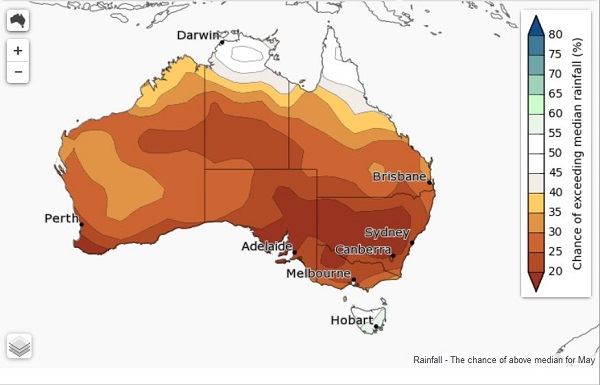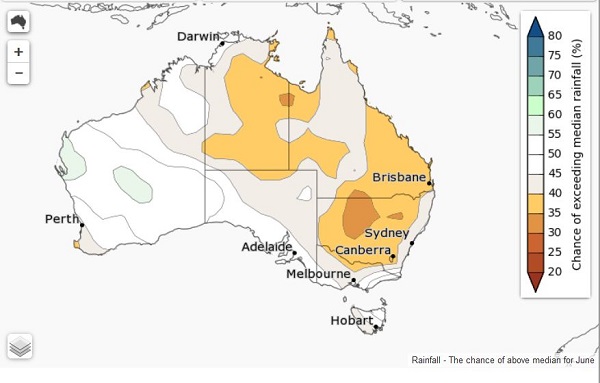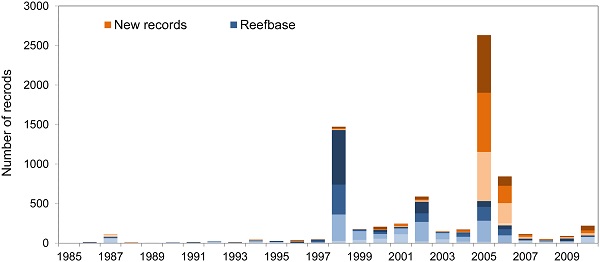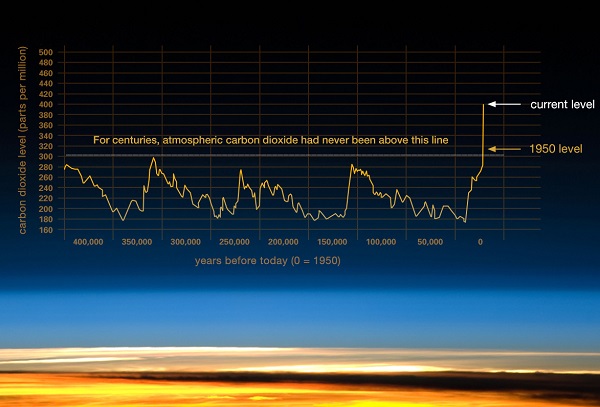1. Weather outlook
The Bureau of Meteorology (BOM) has come out with their monthly and seasonal climate outlook for May-June. This is May rain:

This is June:

Something about warmer Pacific and cooler Indian Ocean near us. Hope it means East Africa gets some rain.
2. Climate change as genocide
Michael Klare says that the failure to assist starving people in East Africa amounts to genocide.
- Major famines have, of course, occurred before, but never in memory on such a scale in four places simultaneously. According to O’Brien, 7.3 million people are at risk in Yemen, 5.1 million in the Lake Chad area of northeastern Nigeria, 5 million in South Sudan, and 2.9 million in Somalia. In each of these countries, some lethal combination of war, persistent drought, and political instability is causing drastic cuts in essential food and water supplies. Of those 20 million people at risk of death, an estimated 1.4 million are young children.
The cost of intervention, to implement existing UN action plans in order to save nearly 20 million lives, is estimated at $4.4 billion. The international response? Essentially, a giant shrug of indifference.
The money was needed by the end of March. Only $423 million showed up.
Meanwhile Donald Trump sought Congressional approval for a $54 billion increase in US military spending (bringing total defense expenditures in the coming year to $603 billion). And he offered to sell Nigeria 12 Super-Tucano light-strike aircraft for $600 million.
Strictly genocide requires intent, but Klare wonders whether this is a foretaste of what we’ll get in a warming world.
3. New, high-resolution global mass coral bleaching database
A Canadian-Australian study has developed the first-ever gridded, global-scale historical coral bleaching database, and a determined effort made to identify all instances of coral bleaching from 1985 to 2010.
- This search increased the number of observed bleaching reports by 79%, from 4146 to 7429.
They found that the probability of bleaching was eight times higher after the 1997/1998 El Niño.
Here’s the graph:

Eight times seems conservative.
That was before the mass bleachings of 2016 and 2017. This article says that reported observations of bleached corals have been observed near-continuously and from across all three tropical ocean basins since mid-2014.
The ABC piece on the main story highlights that Australia has the second worst record in the world. While the basis of that claim is not clear it seems to be influenced by the fact that Australia has a lot of reefs.
4. Turnbull fibbed about Snowy Hydro 2.0
Turnbull told us:
- all that was missing was leadership and money, and that his government has both. He told us the projects were ‘thoroughly commercial’ and the task now was now to provide extra funding for the feasibility study to review the geological studies and the tunnelling technology now available.
Apparently the project is at a very early feasibility stage. Not even the site is final.
The project was for Turnbull to sound visionary.
5. Malcolm Turnbull says hydro plan could make Tasmania a ‘battery for Australia’
That’s probably overcooking what is likely to happen, which is very possibly nothing. A $2.5 million feasibility study by ARENA with Hydro Tasmania has been announced to look into “the feasibility of expanding the existing Tarraleah and Gordon power stations and building 13 pumped hydro projects.” It would “mostly involve connecting existing reservoirs, rather than making new dams.”
The cost is estimated at more than $3 billion to add 2500 megawatts of storage capacity, plus a second Basslink interconnector costing up to $1.1 billion.
6. Renewable energy set to boom
South Australia looks set to get 80% of its electricity from wind and solar by 2021-22.
The other day I checked RenewEconomy’s NemWatch site and SA was at about 75%.
Giles Parkinson says that solar, including rooftop solar, now has a capacity of 6GW, and is set to double again by 2020.
Parkinson also reports on the final draft of the Electricity Network Transformation Roadmap by the CSIRO, and Energy Networks Australia, which represents the grid owners across the country.
The future is splendid – all we need is a government with a climate policy and a plan. Perhaps we should call tenders.
7. Audrey Zibelman embraces change at AEMO
The Weekend AFR ran a very positive article on Audrey Zibelman, the new AEMO chief, fresh from leading the transformation of New York state’s energy network with solar panels and battery storage. She is enthusiastic about ‘distributed’ energy generation and the need for grids to change their business model to facilitate rather than react to change.
She has had 25 years experience in the energy sector, including at PJM, the regional trnsmission company which operated the power grid and wholesale power market across 14 states in the eastern United States.
8. Westpac’s climate lending policy
Westpac has a new policy on which activities it will support with loans in relation to climate change.
- New mines producing coal will less than 6300 kilocalories per kilogram won’t get Westpac finance, a level that is a quarter above the roughly 5000 kCal/kg energy content of coal expected to be produced by the $16 billion Carmichael mine Adani plans for the Galilee Basin.
Hunter valley mines are ruled in, which is convenient for Westpac’s balance sheet. They expect lending for renewable energy to quadruple by 2030.
NASA evidence of climate change
NASA has a site showing the broad evidence of how the world is changing with global warming. Here’s where we are with CO2 concentrations:

In earlier times CO2 was a feedback to forcing from orbital changes. We are doing something quite different now, and we entered new territory in surface temperatures with industrialisation after WW2.
9. The climate could hit a state unseen in 50 million years
- If carbon emissions continue on their current trajectory, new findings show that by mid-century, the atmosphere could reach a state unseen in 50 million years. Back then, temperatures were up to 18°F (10°C) warmer, ice was almost nowhere to be seen and oceans were dramatically higher than they are now.
“Dramatically higher” means about 75 metres higher.
Of course it may take more than 1000 years for all that to come to pass, but I thought you should know that such a paper has been published in Nature.
See also at The Conversation and at The Guardian.
If we keep going as we are into the 23rd century, the Earth system response “would likely be without geological precedent in the last half a billion years.”
The sun is 30% brighter now than when it was born 4.5 billion years ago, so its increasing brightness makes a difference over hundreds of millions of years, as well as CO2 levels.


Another possible consequence of melting permafrost. (The author is a little too breathless for my taste, but the risks are doubtless real).
zoot, it seems to be a known unknown:
I don’t see any rise in deaths from malaria, cholera and dengue fever, quite the opposite.
Economic health tend to be the main drivers that influence those not temperature as far as can see.
From here.
Jumpy, I’ve found a few items on health for the new CC.